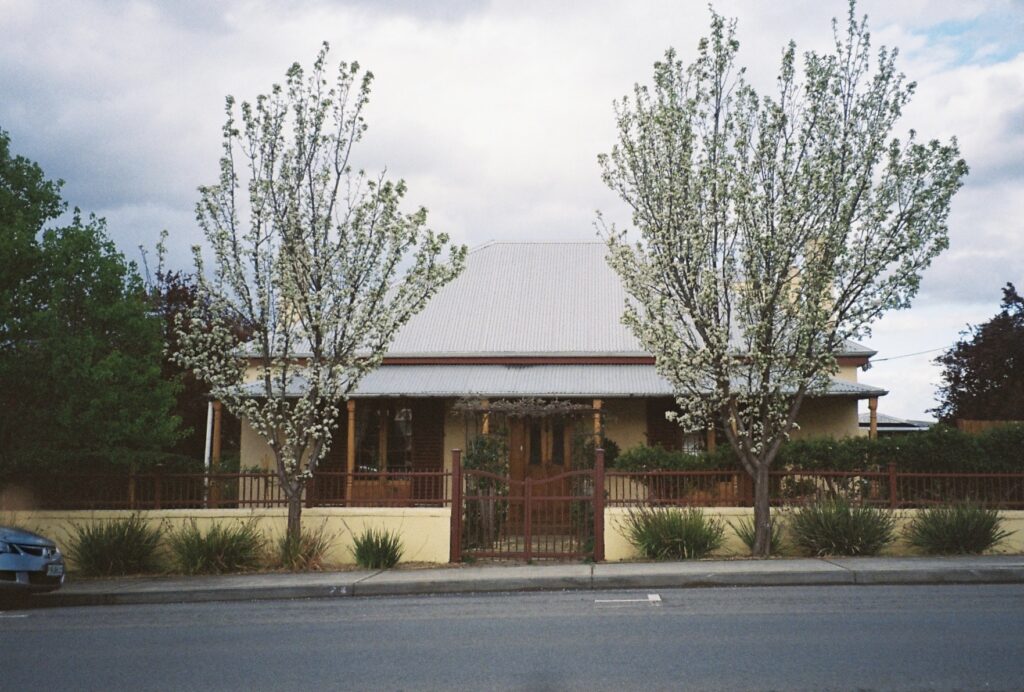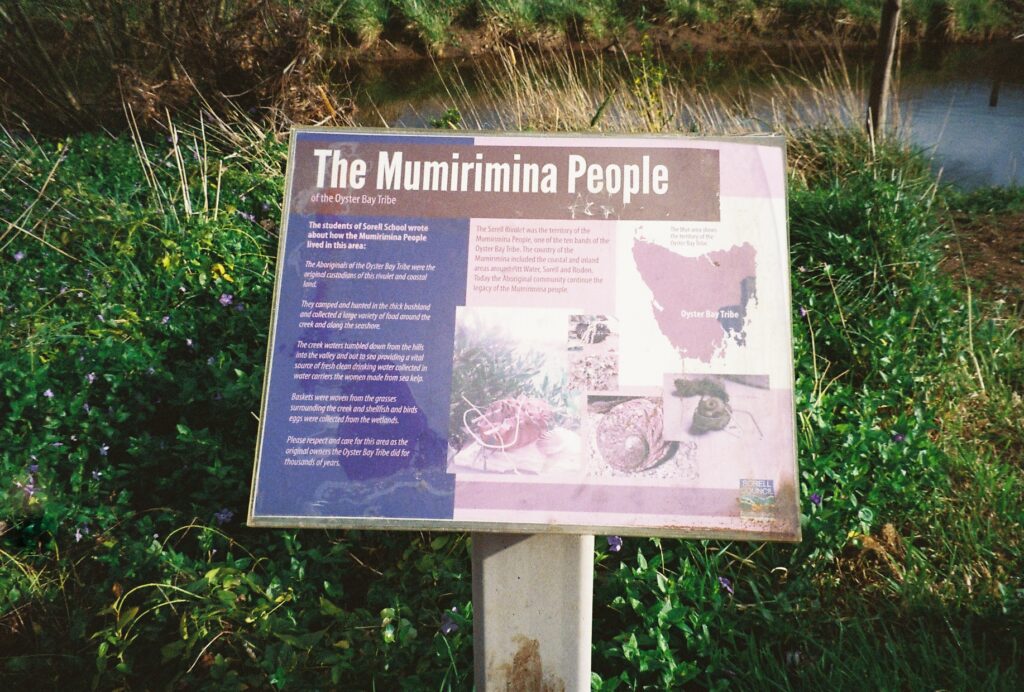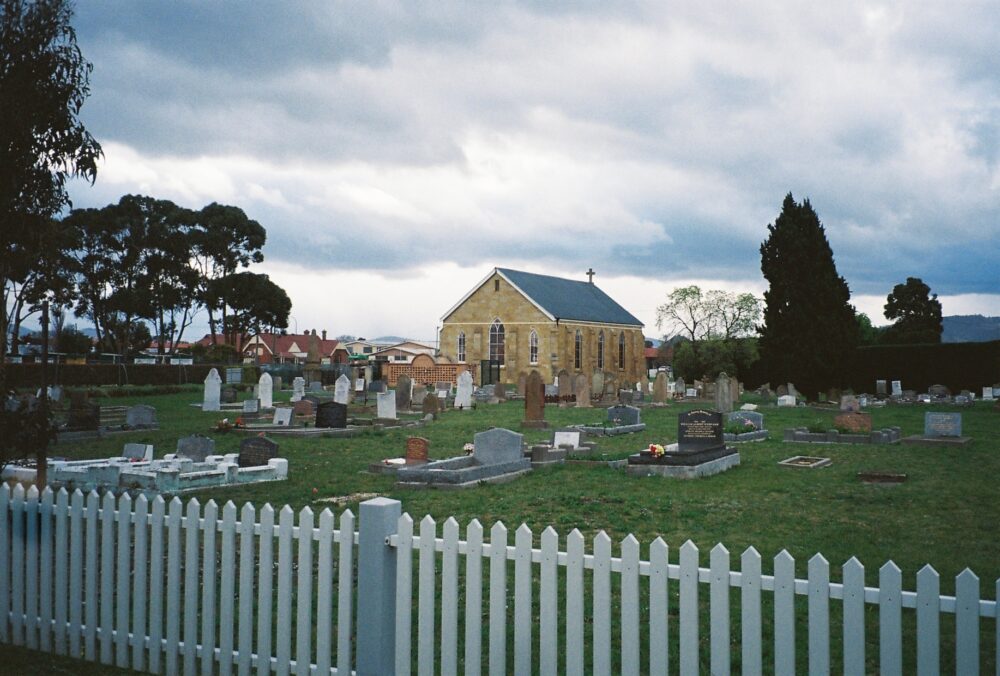Two hundred years ago, Sorell was given its name by Governor Lachlan Macquarie whilst on a tour of Van Diemen’s Land. Sorell, earlier called Gloucester, saw its first white settlers in the early 1800s, as freed convicts were granted land in the area. As farms began producing, the area became known as the granary of Australia. In the 1810s and 1820s the town grew as a result of its successful farming, attracting a doctor, postman, regiment, magistrate and school teacher.
Interspersed between the new Coles, petrol stations, weatherboard houses and a plethora of takeaway shops, century old buildings stand as memories of Sorell’s convict and colonial roots. There’s three sandstone brick churches which seem far too glorious for the small congregation that existed when they were built. Close by, there’s a handful of houses and homesteads with immaculate gardens. Down the road, there’s the Barracks, built in Colonial Georgian style. A few streets over, there’s the Old Council Chambers and dotted around the town are old hotels, adorned with rusting but ornate balustrades and railings.

These buildings, often emblazoned with name plates or historical plaques, are just one way in which the township celebrates its colonial history. On the fence of the cemetery at St George’s Anglican Church are information signs, describing some of the key pioneering families buried there. Across from the cemetery is the Pioneer Park. Local groups research key figures in Sorell’s history and bring them forth to the light of the twenty-first century. Sorell has a history room in the Sorell Memorial Hall. The town even has a Pioneer School, where the local children are taught about the history of the area.
One man who seems to personify Sorell’s pioneering history is Alexander Laing. Born in 1792, Laing was charged with theft and transported to Sydney, before being later transferred to Van Diemen’s Land in 1815. He was married the following year, fathering twelve children over the course of his life. After being granted his freedom, Laing served as the District Constable of Sorell between 1819 and 1838. During this time he chased and captured bushrangers such as Lumpy Jones.
In 1863, after spending some years in New Norfolk, Laing moved back to the area where he recorded, in a manuscript, 64 of his original fiddle tunes. Many of the songs are inspired by the local area, with titles such as Sorell Windmill and James Gordon of Forcett. He is now celebrated for his part in Sorell’s colonial history, with his manuscript of fiddle music stored in the Tasmanian Archive, a biography published, and musicians bringing his songs back to life.
Laing is still present in the living remnants of Sorell’s past. The Police Magistrate’s House, on the main street, was built on a parcel of land that Laing originally owned, but had to forfeit to pay off his debts. This cottage is still incorrectly labelled as the Chief Constable’s house. Laing’s daughter, Georgiana, was the first to be baptised in the regal St George’s Anglican Church. The Sorell Gaol, where Laing was held up by the infamous bushrangers of the Brady Gang, was demolished in 1910 in order to build the Old Council Chambers. Laing’s descendants are buried in cemeteries in the area, and some even still walk around the town.
But Sorell’s history has a dark side — with Laing at the centre — which is not part of the colonial mythology perpetuated in the town.
On the 8th of December 1826, a group of Mumirimina people, the first people of the area, were seen walking through Country near Pittwater. Laing gathered four soldiers and some stock-keepers, followed the group, and waited until dawn the next day to set upon them. They captured ten Mumirimina people, including Kikatapula, four other men, four women and a child. This story was reported by Magistrate James Gordon in a local newspaper later that week. What was not reported at the time, was that Laing and his compatriots chased fourteen others up the Sorell Valley to the headwaters of the Sorell Rivulet, where they killed them by gun-fire and bayonet.
This is not the only massacre to take place in Sorell. In June 1829, a party pursued and killed ten Mumirimina people after they raided huts in the area in search of food. Two years later, the Black Line, which aimed to push First Nations people in lutruwita/Tasmania onto tukana/Tasman Peninsula, ran through Sorell. Settlers from the area participated in the Black Line, alongside Lieutenant-Governor George Arthur and his soldiers, who stayed at the Sorell Barracks. It’s likely that further kidnappings and killings of Mumirimina people occurred in the area, but were not documented by the white settlers.
I’ve known about the colonial history of Sorell and its surroundings since I was a child. But after twenty-four years of living in the area, I’m ashamed to say I’ve only just learnt about the massacres of the Mumirimina people here. Not only that — I didn’t even know the name of the area’s first people until I actively sought out information about them this year.
I examined my memory and the key monuments around the area, trying to determine why I had spent the last twenty-four years in ignorance. At primary school, and at Sorell High School, I remember being taught some things about the culture of First Nations people, in a very general way. Some of our house teams, and the streets around Dodges, seemed to be named in a First Nations language. But I don’t remember ever acknowledging that we were on the Country of the Mumirimina people, learning about their connection to this land, hearing about the atrocities committed against them, or how they fought back. The likelihood of my having learnt this and forgetting it seems unlikely, given how much I remember us learning about the First World War in school.
From the little I’ve seen, things seem to have improved since I was in school. The Sorell Pioneer Village has had a yarning circle since 2012 to educate primary school students about First Nations peoples, and the kids at Dodges Ferry Primary School go on excursions to learn about their history. The Mumirimina people are now acknowledged at Dodges Ferry Primary School, and on information signs around Sorell and Carlton River.
Whilst there is some information about how the Mumirimina people lived on these signs, it often seems to be tokenistic and overly simplistic. Some of these signs do not even refer to the Mumirimina people by name, and simply as the ‘Aboriginal people’ of the area. Equally, there’s no celebration of the Mumirimina people’s quest to survive on the land where they had lived for thousands of years, despite being forced off it by settlers. There’s no mention of how the Mumirimina people fought back against those who had stolen the land and their people, through raids and defensive tactics.
For all of the celebration of pioneers around the area, there’s not one mention of the massacres of the Mumirimina people. The main sign to the Mumirimina people is actually on the Sorell Rivulet where the massacre took place, but does not speak to the atrocities that happened there. There’s a monument to those killed in the First World War at the RSL, but no remembrance of the Mumirimina people killed in the frontier wars in the area. Even in the histories of Laing’s life, his taking prisoner, let alone his killing, of Mumirimina people in 1829 is not mentioned, despite it being well documented in newspapers at the time and other internet sites today.

Knowing the full history of Sorell and its surrounds changes the remembrance of Laing from a colonial fiddler and protector of a town of bushrangers, to the only named perpetrator of genocide against the Mumirimina people in the area. In changing how Laing symbolises Sorell’s pioneer past, it elucidates a broader picture of its history — one where Sorell’s settlers were at conflict with the first people in the area, participating in the Black Line and massacres of the Mumirimina people.
This is a truth which must be told in Sorell. The town cannot keep celebrating its colonial past without acknowledging the deep history and culture of the Mumirimina people, and the injustices perpetrated against them, upon which Sorell’s pioneering history is built.
Dominic Flynn has written a string quartet drawing on Laing’s fiddle music, which aims to bring to light Laing’s part in the massacre of the Mumirimina people and challenge the celebration of Laing as a pioneer fiddler. In doing so, his piece reflects on his changed perceptions of the pioneer history of his hometown. The ideas behind this article, and my own reflections on Sorell’s history, are entirely thanks to Dom’s inspiration. His piece will be premiered in February of next year.
For more information on the Mumirimina people, read this article by the Tasmanian Aboriginal Centre.








